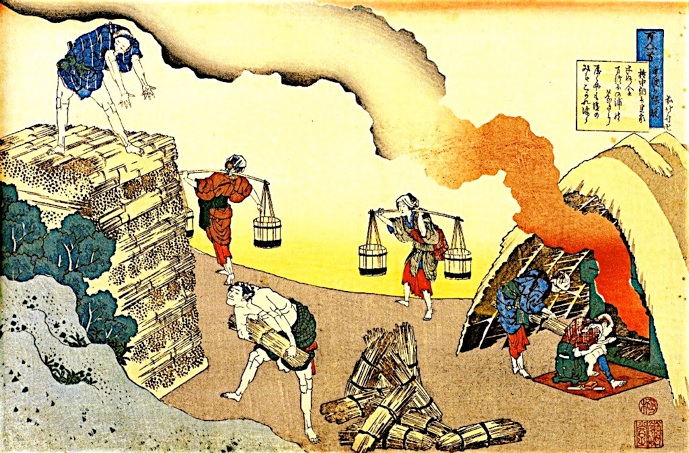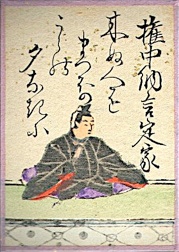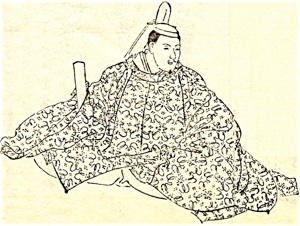権中納言定家

来ぬ人を
まつほの浦の
夕なぎに
焼くや藻塩の
身もこがれつつ
ごんちゅうなごんさだいえ
こぬひとを
まつほのうらの
ゆうなぎに
やくやもしおの
みもこがれつつ
Fujiwara no Teika
For the one who does not come
I wait on Matsuo Beach
In the evening calm
When kelp is boiled for salt
And I too burn with longing.
Hokusai
Fujiwara no Sadaie (1162 - 1241), also called Fujiwara no Teika or Gonchunagon Sadaie, was the son of Toshinari (poem 83). He was the compiler of this Hyakunin Isshu anthology, the Shin Kokinshu (New Kokinshu) and the Shin Chokusen Wakashu.
Teika is one of the giants in Japanese literature. He wrote a novel, Matsura no miya monogatari (Tale of Matsura Shrine), and the Meigetsuki (Record of the Bright Moon), a diary. He also compiled or re-edited older works, like the Genji Monogatari to which he added notes, and Ki no Tsurayuki’s Tosa Nikki. The Shui Guso is his personal poetry collection. He has 467 poems in imperial collections.




Teika by Yosai
This poem was composed for a contest on the theme of love, and the person speaking is a woman. It refers to a poem in the Manyoshu, part of which goes like this:
...
淡路島
松帆の浦に
朝なぎに
玉藻刈りつつ
夕なぎに
藻塩焼きつつ
海人娘女
ありとは聞けど
見に行かむ
よしのなければ
...
The Manyoshu (Collection for Ten Thousand Generations) poem belongs to the early literary period (686-784), which is characterized by a great influence from the Chinese language and poetry, and a flourishing of Japanese poetry.
Konu hito wo matsu means ‘waiting for the man who did not come’, while matsu is also part of the placename Matsuho no Ura and means ‘pine tree’, and ho in itself is ‘sail’. Moshio is ‘salt from burning seaweed’; but there is another connotation as moshiogusa means ‘seaweed used for making salt’ and ‘anthology’, suggesting a link between ‘burning seaweed for salt’ and ‘making an anthology’.
The Japanese had invented a way to extract salt from seawater and seaweed. Seaweed was dried on the beach, then added in a pool in which pure sea water was left to evaporate. Finally, they boiled the briny mixture over a fire: The water gradually evaporated, leaving behind salt crystals and ash from the seaweed, the moshio. It is still produced today, but the seaweed is removed before boiling the brine.
Hokusai shows us the burning of seaweed, women on their way to fetch seawater, men piling up the firewood, others keep the fire going. On the left is a pile of seaweed. These people are working hard to produce the salt from the sea, collecting various components like an compiler making an anthology.
...
Awaji Island
on the Bay of Matsuo
in the morning calm
they reap jewelled seaweed,
in the evening calm
they boil seaweed for salt,
the fisher-maidens -
and though I hear they are there,
since I have no way
to go to see them
...
